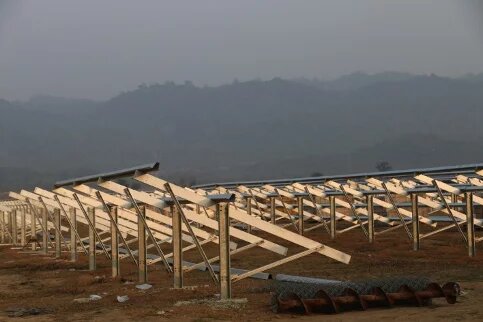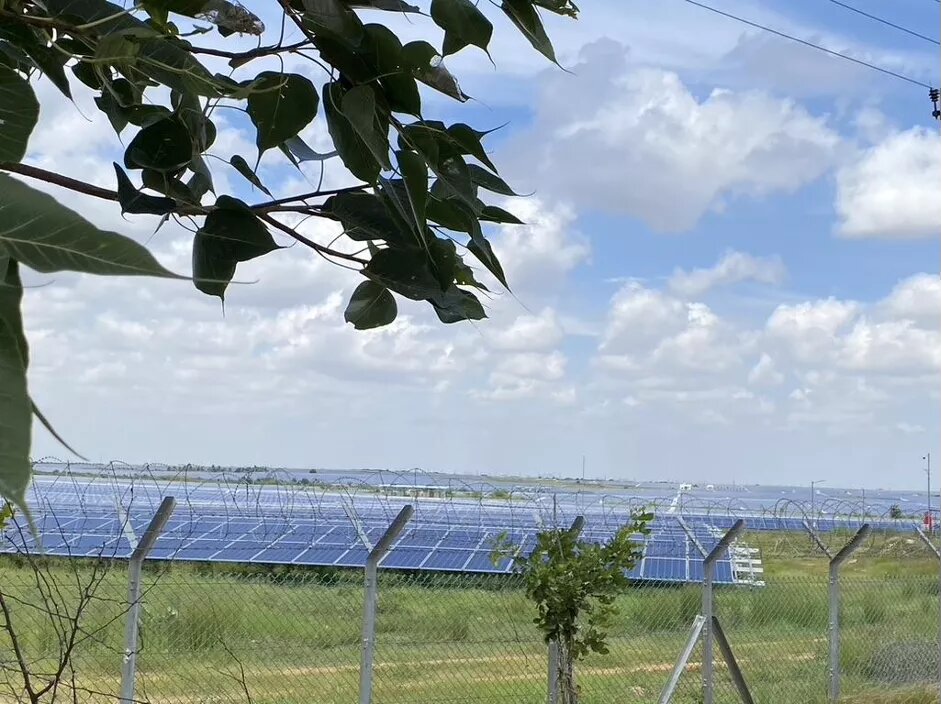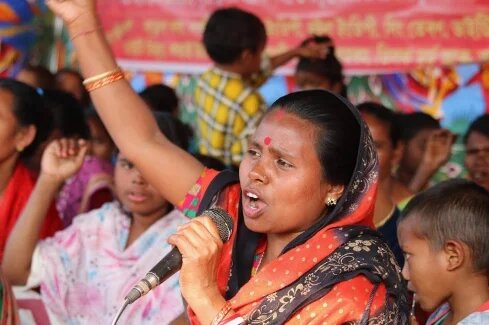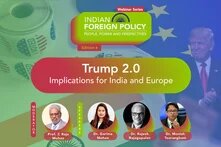
Environmental and social justice researcher Bhargavi S.Rao on noticeable absence of intelligentia, academia, scientific community, independent media, and gender considerations at C20 discussions.

In the run up to G20 Summit in September 2023, our staff member Sadia Sohail spoke to some prominent members of civil society working at the front of ecology, energy, development, climate and gender to get their views on the discussions and deliberations in the C20, G20 meetings, ministerials et al. Energy transition is one of the priority agendas set by the G20 working groups and one where India is leading the way. Today, India is the third largest producer of Renewable energy, has an ambitious National Hydrogen Mission, progressive policy on electric vehicles and incentive mechanisms for manufacture of solar technologies, supporting off shore wind and battery energy storage. While, the country is making large strides in transitioning to renewables for its energy needs, it also grapples with how to make this transition just and inclusive. We conducted the interviews to get varied perspectives on energy transition underway in light of social and ecological concerns, and highlight potential role the civil society can and should be playing within these processes. The interviews are a part of our dossier ‘G20 in India’ on hbs, Regional Office New Delhi website.
The interviews were conducted over email. The views and opinions expressed in the interviews are those of the respondent(s) and do not necessarily represent the views of the Heinrich Böll Stiftung.
SS: What has been your assessment on the discussion with regards climate and energy in the Civil 20 (C20) processes of Group of Twenty (G20)?
BR: All C20 efforts were chaired by Mata Amritanandamayi, also known as ‘Amma’ or the ‘hugging saint’, who started a Math (a Hindu religious centre) in her name. Over the decades, this Math has built an expansive organisation with major investments in education and charity.
India is home to thousands of civil society organisations(CSOs) that are active across mountains, hills, plains, riverine deltas, desert, wetland and coastal landscapes. Over time, these organisations have worked with local communities advancing meaningful development. Several have also interrogated and contested certain development paradigms, especially mega projects such as dams, mining and infrastructure projects, which have caused severe, and often irreversible, environmental and social injustices. There are dozens of CSOs, which work at national and international levels drawing attention to various policy and programmes implications of international developmental organisations and financial institutions. As a consequence of all these efforts, there have been concerted efforts in raising concerns about human rights, socio-economic and environmental safeguards.
Such efforts have dovetailed into building domestic laws and regulatory standards to address prevailing gaps. When necessary, such CSOs have not hesitated approaching courts, and there have been several path breaking rulings directing the government to close gaps in governance, address socio-economic disparities, advance education and health for all, provide access to justice and attend to environmental injustices.
Peculiarly, none of such organisations were invited and involved in any of the C20 events, especially in a meaningful sense. The entire C20 process was marked by an overwhelming presence of Hindu organisations, and it was visible from the very inception of this process in India. The inaugural, in particular, was remarkably populated with saffron clad Hindu religious leaders, and drew criticisms from several quarters that the Indian government had turned C20 into an assembly of right wing ideologues. As a consequence, almost the entirety of India’s civil society, especially progressive organisations that value the syncretic traditions of the country couched in a secular idea of governance, stayed away from any engagement with this process.
This says a lot about what defined the nature of C20 in India. Besides, there has been a remarkably noticeable absence of the intelligentsia, independent media and academia, as well as key representatives of research and the scientific community, in any of these events. As for the discussions conducted by C20, they have been ostentatious demonstrations of hegemonic state power, with rather rare presence from local governments and communities. A close study of the series of events held across various cities reveal that the process was turned into an effort to showcase the city where C20 events were held, and the thematic focus was subsumed in it. In some cases, C20 events were employed to garner investments.
Most worryingly, C20 and G20 events caused violent sanitisation of cities where they were held. The targets, almost always, were low income neighbourhoods, as was the case in Delhi. In other places, in the guise of sprucing up historic towns and villages, street vendors were cleared out. Hurriedly designed and shoddily implemented beautification of roads and highways, with crass employment of glitziness, were undertaken. Thus, the focus was not on the content and meaning of the theme and place.
Equally disconcerting was the massive investment of public money on what clearly were promotion of claimed achievements of Prime Minister Narendra Modi and his administration. That India is a major centre of very structural and broad-based civil society action was largely missing in focus. The focus was on securing the support of the big media, with comprehensive neglect of local media, particularly the regional press.
As the forum was used to gloat about the Modi administration, there obviously could not have been any discussion of how hundreds of civil society workers, lawyers and academics who spoke their minds without fear, had been targeted and several were in jail on what was broadly accepted as fabricated charges. The projection has been that India’s civil society is thriving, works without fear, and the government is highly supportive of their freedoms. When, the contrary is true.
A review of the G20 and C20 websites and information packages focusing on events addressing climate change reveal that there has been poor acknowledgement of field realities. The Union Power Secretary, for instance, said in one of the events that with increased emphasis on grid interconnections, India was promoting "One Sun, One World, One Grid” effort, and this could lead to better utilisation of available energy sources amongst member countries. But there was no admission of the fact that such advocacy of solar power expansion, without focusing on the awful lack of storage capacity, is by itself a flawed approach in promoting renewable energy as the mainstay of extending energy security. This is indicative of how the promotion of tapping sun’s energy as a perpetual possibility does not comprehend inherent systemic inadequacies, and also the fact that its advancement has embedded carbon and extractive paradigms of development. Besides, in the narratives of how renewables are promoted, there is almost a complete surrender to market oriented approaches, and the capabilities of the investing community benefiting with profits; not as is to be expected, the advancement of human well-being that is the State’s fundamental obligation.
The sun shines bright across the planet, and each micro-region could be viewed as a self sustained unit. But it is when energy demands are posited from the point of view of industrial scales of consumption, plugged as it is with every region being perceived as a production site, not a place of living harmoniously with nature that disparities emerge. And this is particularly the case in the advancement of renewables as the sun does not shine equally across the earth in supporting such industrial scale demands. Which is why grid interconnectedness becomes a major infrastructural requirement to the overall success of transition to renewable energy. Besides, embedded as these projects now are on commercialisation, and success in market terms, policies are largely supportive of investors’ demands, and rarely, if ever, care about the welfare of local communities or the impacts they suffer from such mega projects.
Both in development of the energy projects, and the transmission infrastructure to distribute the energy produced, resources demanded are extractively supplied and land intensive. Case after case of solar park development in India is mired with such impacts, such as at Pavagada (Karnataka), Challakere (Karnataka), Mikir Bamuni (Assam), and Rewa (Madhya Pradesh). In each and every one of these locations, lives and livelihoods of natural resource dependent communities have been ripped out of the landscape that they lived in for thousands of years. And such impacts are indicative of what is happening in just about any country where agro-pastoral livelihoods and indigenous communities live, whose lands are now diverted to such mega utility scale renewable energy projects, almost always without their due consent, without their participation, and always by rendering them homeless and hopeless. That these very communities are those that have not in the least contributed to global warming and yet are victims in addressing its consequences, is the irony of the overall approach of this form of development.
The C20 process has had no discussion whatsoever on any of these aspects of the transition to renewable energy. This is particularly problematic given how Prime Minister Modi has set an highly ambitious target of achieving 500 gigawatts (GW) of energy produced from renewables by 2030. As it stands, what has so far been implemented is half of what was expected by 2023. And if the gap is to be closed in the remaining part of this decade, it can well be imagined how aggressive and extractive the process is likely to be. In enquiring all these aspects, C20 should have been an apt stage. But the opportunity was never there, as the entire discussion was focused on claiming success already, and in securing investments for expansions planned. As a consequence, there is in all likelihood the promotion of highly industrialised and commercialised energy infrastructure to bring in renewable energy as the mainstay of energy security, a paradigm nested within the prevailing extractive form of development. There has been no scope for such critiques in the C20 process.
A review of the documents supplied on the C20 website reveals,[i] however, that there can be hope. As one document shares: “Participants, however, shared the view that the energy transition pathway should be different for each country depending on its energy base and potential.” If this line is read and understood in context, it can be perceived as G20 being respectful of regional variations and disparities, and not serving as a platform promoting an homogenous, and thus deeply problematic, approach of transitioning to renewables. This slender hope then presupposes that possibility of a nuanced understanding of ground realities, rather than supporting the prevailing unthoughtful pouring of investments covering unique natural landscapes with solar parks, a veritable sea of glass.
SS: How has the ministerial meetings, ensuing discussions and negotiations fared on “women led development” so far? Would you agree on this being a cross-cutting agenda across G20 themes and engagement groups?
BR: A word search of press releases and documents on the G20 website reveals no mention of the word ‘women’. And in speeches and videos available on the G20 website, there is absolutely no mention of or attention given to ‘women led development’. However, the gallery of pictures shows women’s participation in many events. The few newspaper reports that cover some of these events have no reporting on anything structural and substantial being proposed about empowering women, or in forestaging women-led development.
SS: India’s energy transition is underway. It holds promises of opportunities and new avenues being created. How do you see the transition unfolding?
BR: The transition is unfolding with absolutely no discussion on the challenges and contestations it is causing over land and livelihoods. There is an absolute lack of focus on gender empowerment, advancing food and water security, and also the fragmentation of communities. There is, quite simply, no attention paid to the irreversible impacts on local and regional ecologies. There is also no visible effort or active mentioning of the intent of not leaving behind anyone in organising this ‘just transition’ to renewable; this is particularly evident in a marked absence in focus on ensuring energy security for all. There is then no focus on protecting natural resources and habitats that would be disturbed by such transitions. The discussions largely revolve around financing, types of finance, access to technology, and policies supporting investors and investments. None of the discussions touch on the needs of local communities, such as the importance of skill building or upskilling of those displaced, and there is no focus at all on assisting affected youth in taking up opportunities through the new developments.
There also has been no focused discussion on the fact that much of the renewable energy installations have come at the cost of sidestepping local land, water, environmental and human rights protection laws. Although civil society efforts to challenge such decisions in courts have resulted in progressive orders, they have rarely been implemented. Rather than harmonising the new developments with progressive laws and judicially upheld principles and regulatory norms, the effort has largely been to create associations of investors, renewable energy developers and regional governments, including by forming special purpose vehicles (SPVs), and rushing projects through speedy decisions for implementation and without considering the concerns of any or all of the impacted communities. As a consequence, those losing land and livelihoods, and without any alternate ways of living, are literally just left in the dark.
Such a transition is leaving behind a large section of the population in the lurch, and that without any consideration of their rights to appropriate livelihoods. If this paradigm of renewable energy development continues, it is likely to aggravate prevailing disparities and in all likelihood would result in lack of food and livelihood security at the household levels of impacted areas. This, in turn, will have substantial, and probably irreversible, impact on local socio-economic and health indicators. All this will result in serious adverse consequences on women and children.
SS: Do you think it is sustainable, participatory and inclusive?
BR: The entire process is certainly not sustainable as it will eventually lead to land related conflicts; it is already widening the gaps between the rich and poor in areas where renewable energy projects have come up. For example, in Karnataka’s Pavagada, the rich landlords gained from leasing their land to the massive solar park, while the small and marginal farmers have acutely suffered. Worse is the case of landless labourers and pastoralists who were left without access to secure livelihoods. This will cause social instability and pave the way for increased incidences of crimes and different kinds of social tussles considering existing caste, class and religious divisions. Moreover, in a highly polarised political context, diversities could be employed to fuel conflicts.
The normative processes of decision making are also far from participatory. The local panchayats have been kept out of decision making, although non-conventional energy is a direct function of the panchayats under the 11th Schedule of the Constitution. As most renewable energy projects have been removed from the purview of environmental appraisal and clearances (a 2009 Ministry of Environment, Forests and Climate Change circular claims solar parks are without environmental impact and thus need not be reviewed as per the EIA notification), public consultations have not been held about their impacts. The projects have not been subject to environmental and social impact assessments as a core part of regulatory approval.
Local CSOs, academia, and the public are, thereby, largely kept out of these decision making processes, which are far from being inclusive and democratic. Project affected communities are always in the dark and wake up to the developments only when there is activity on the ground. By that time it is already too late to question and contest, as the land has transferred possession and earth work is undertaken destroying local landscapes. The persisting lack of transparency and accountability in the entire decision making process relating to renewables seems to be the order by which such project decisions are formulated, proposed and implemented. This situation is in stark contrast to India’s commitments as per the Rio Declarations, the ILO Convention on Labour, UN Declaration on Indigenous Rights, Convention on Biological Diversity, IPCC agreements, etc., where the country claims to be upholding international human rights and environmental protection standards through local laws and regulations. Which, India is not doing, quite obviously.
SS: Does the discussion, planning and decision making on energy transition include questions and responses related to gender needs and interests?
BR: There is no mention of the word gender in all the discussions relating to planning and decision making on energy transition. Women and girl children bear the brunt of the adverse impacts of such transitions, and have had absolutely no place in the decision making processes.
As such, the patriarchal nature of land ownership in the country leaves women out of any discussion about land deals, be they about lease, rent or sale. Women who find creative ways of sustaining their families through their labour and inventiveness, say, in harvesting a variety of greens from lands even during the harshest of climatic conditions, are completely disempowered when they lose access to land. This quickly translates into impacts about their access to nutrition, and thus the health of the entire household suffers.
Once the land is leased, most men migrate out, leaving women to fend for themselves and care for the young and old. Without financial stability, girl children are often pulled out from school and subjected to helping with all chores at home. They are even married off young when their bodies are not ready for a reproductive life. This will certainly have its implications on maternal mortality and infant mortality in time.
There are no jobs in the renewable energy sector for women and there is very little effort to ensure the sector employs women. Installation of solar and wind and renewable projects are all by men. Maintenance and security is also by men. Women are hired on a contractual basis occasionally to cut grass or for cleaning the glass on solar panels. The skill development courses offered mostly in cities do not cater to women’s needs, and are hardly ever located in rural areas. This has kept women far away from being engaged and/ or employed in this sector.
In areas where communities have parted with the land, there is little guarantee that all homes in all villages are electrified. A power line reaching a village does not mean all homes have equal access to electricity. Caste, class and religious minorities often suffer and their homes lurk in darkness with the women having to walk long distances to find and bring firewood to keep the kitchen fires burning, particularly as seen in a Dalit colony in Volluru village in Pavagada.
In some small towns such as in Bandahalli in Chamarajanagar district of Karnataka, where solar parks have mushroomed, the households do get electricity for lighting purposes throughout the day, but they lack power to run their water pumps. They have to be awake at odd hours in the night hoping for regular power to ensure water supply to their fields. In many other cases, the scarce supply of energy is evident from only the living room being lit with a charger point to charge a phone, while the women toil in the kitchen with firewood and in darkness.
The current series of events as part of G20 and C20 have completely failed to address these existential questions of gender equity and energy equality, particularly from the perspective of needs of women.
SS: How significant are gender considerations in the political economy of just energy transition in India?
BR: For a massive and mixed economy that India is, which is unfortunately gauged from a very narrow perception of GDP based growth, that women contribute a substantial amount to the economy is entirely missing from the G20/ C20 discussions. Equal access to energy and the quality of energy is very crucial for a continuing and central role of women in the economy. But given that the percentage of women employed in the industrialised and formal sectors is low in the country, and women’s role in the economy is hardly recognised, the prevailing lack of political will in correcting this major gender impasse is sustained by the shallowness of G20/ C20 debates/ discussions. Gender considerations should have been at the core of these discussions at all levels. But, not only is there no acknowledgement of their critical roles, they have been conveniently kept at bay.
SS: Heinrich Boell Stiftung is currently in the process of initiating a platform for dialogue on feminist approaches to just energy transition. What would be your recommendation for such a platform in terms of thematic focus, formats for dialogue and relevant actors to be included?
BR: It is a crucially needed platform and should focus on inclusive access to energy, especially access to clean energy produced through an inclusive societal process and completely conscious of environmental implications, and proactively focused on ensuring access to energy in homes, agriculture, and other agro-pastoral livelihoods as a key priority. As energy is a key driver of any ecosystem or society, its role should also be located within a very enlightened understanding of the nature of the society and how any new intervention will affect it. Then, it should be focused on interventions that are crucially empowering of women and other marginalised communities.
The formats for dialogue should be through deeply experiential field visits across multiple landscapes, by organising meaningful focus group discussions and perhaps also through individual learning efforts and group interviews. There must be mechanisms for the government, industry, investors, civil society, academia and local communities to come together and have dialogues in a truly open manner. Facilitating such dialogues, taking particular note of the importance of protecting dissenting voices, especially of impacted communities and civil society, is crucial in countries where human rights, particularly freedom of expression, are under systematic attack.
Focus must be invested in ensuring relevant participants are part of this conversation. An illustrative list of people who must be included in the dialogue is representatives of impacted local communities, academics, village panchayats, anganwadi workers, health workers, school teachers, students and women at the household levels, not to miss those who are engaged in the sector in some form or the other.
Endnotes
[i] The C20 Principles approved during the C20 held in Japan in 2019 could not be accessed at the link https://civil-20.org/cgi-sys/suspendedpage.cgi. It read ‘Account suspended’.




